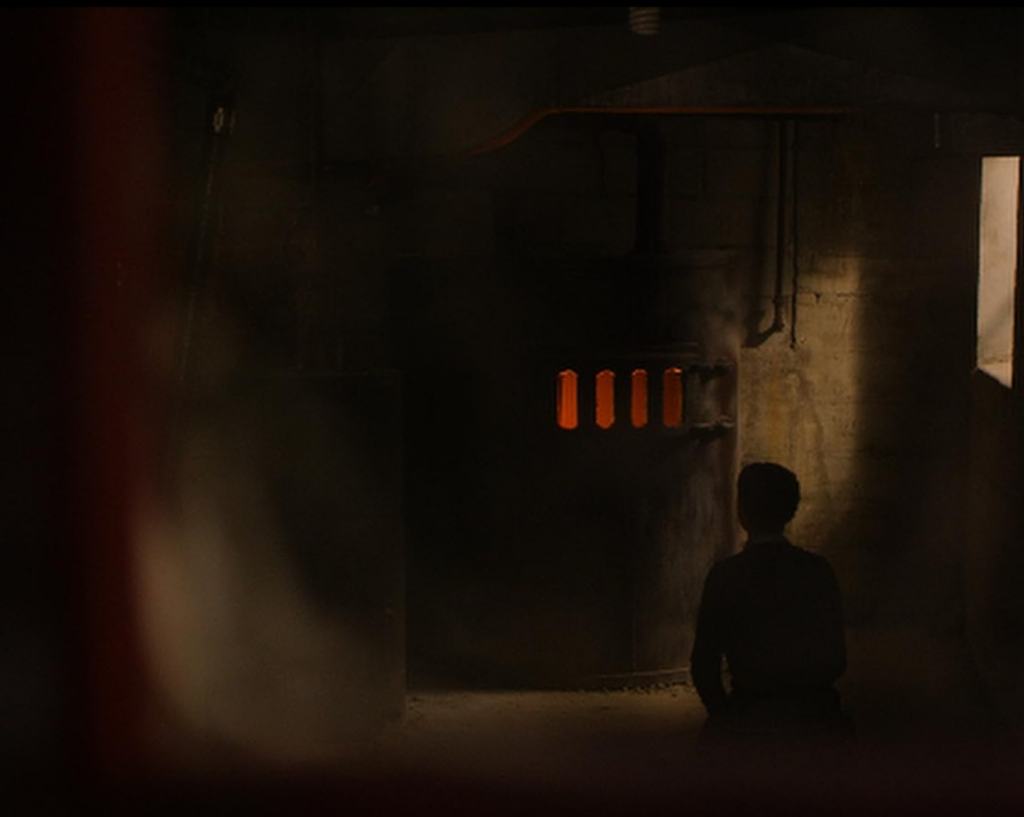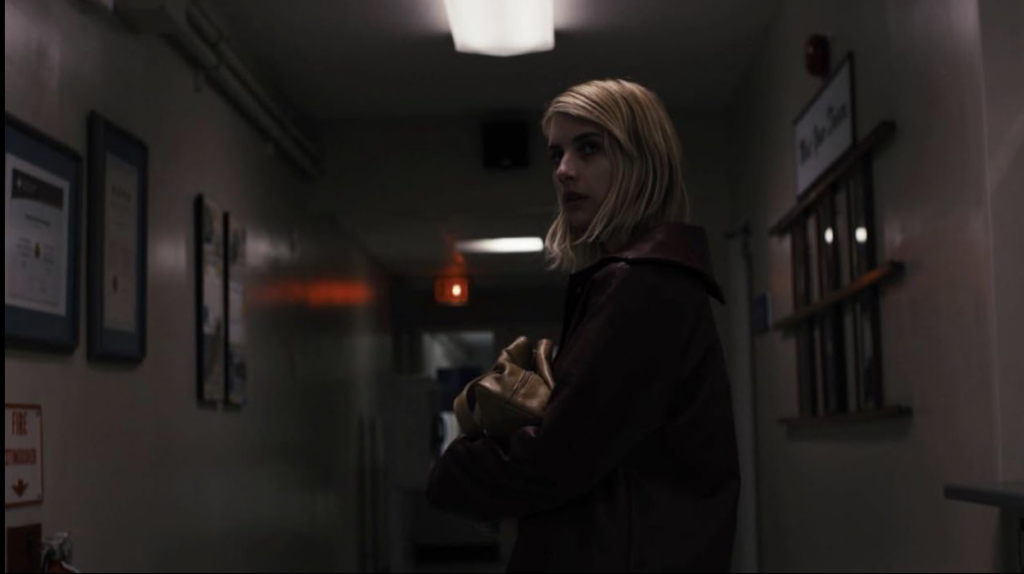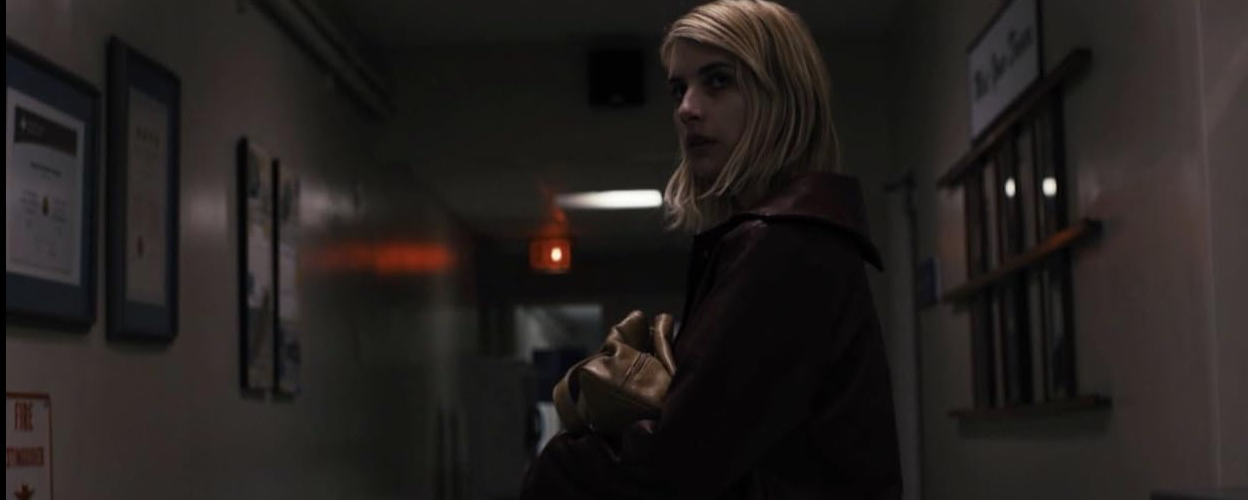
Welcome to Watching the Dark, a new regular column featuring essays and articles about horror films. Written by Terry Morgan.
The Blackcoat’s Daughter from A24
The Angels, They Forgot Her
For myself and presumably many other horror cinema fans, the most exciting event this year is the upcoming release of Oz Perkins’ new film, Longlegs, which premieres on July 12th. I’m a big admirer of his work, and to celebrate this occasion I’d like to write about two of his previous movies, the first of which is his directorial debut from 2015 (although not released until 2017), The Blackcoat’s Daughter. It’s one of my favorite horror films from the first quarter of the twenty-first century, a masterpiece of wintry atmosphere and the tragic effects of desperate loneliness. To fully discuss the film, spoilers will be necessary, but they’ll be clearly marked so as not to ruin the experience for any readers who haven’t seen the film.
Kat (Kiernan Shipka) and Rose (Lucy Boynton) are both teenaged students at Bramford Academy, a Catholic boarding school in upstate New York. In February, the school has closed for winter break, leaving behind only the two girls and two nuns who reside on the campus. Kat’s parents have neither called nor shown up to get her, which worries her, but she’s assured by her headmaster that icy road conditions may simply have delayed them. Rose, who fears she may be pregnant, has lied to her parents to delay their arrival and buy herself some time to figure out what to do. Elsewhere, Bill (James Remar) has discovered Joan (Emma Roberts) sitting on a bus bench in freezing weather and has offered to give her a ride at least partway to her destination. Meanwhile, somewhere in the bitter cold and darkness is something darker still that will bind them all together.
Shipka, who was 16 at the time of filming Daughter, had just finished eight years of being on Mad Men, which makes her impressively composed performance a bit less surprising. She initially portrays Kat as lonely and scared, a child inexplicably abandoned by her parents, a freshman left in the care of a senior who wants nothing to do with her. As the story goes on, however, Kat gains in confidence, and Shipka plays the role with a precisely unsettling ease, as if she has just figured out the secrets of the world and is quietly marveling at her transition.

If Kat’s character arc is that of an unnoticed person gaining agency, Rose’s arc is the exact opposite. When we are first introduced to her, it’s at a photo shoot in which she smiles like a glamorous starlet, shot in dreamy slow motion with jangly guitars on the soundtrack, evoking the off-the-charts charisma of Audrey in Twin Peaks. But the moment the shot is over, her face falls – Rose is in trouble. Boynton convincingly plays the role as a young woman used to getting her way who is gradually realizing she may be seriously out of her depth.
Roberts gives the most interesting and unusual performance in the film, which is more remarkable for being almost entirely internalized. Joan has very little dialogue; her response to almost every question is silence. Roberts is largely known these days from years playing very broad, usually bitchy, characters on many seasons of American Horror Story, but her work here is admirably subtle, composed of veiled glances and hidden thoughts. She also gets the movie’s single most powerful and memorable scene, in which she makes an affecting and indelible impression, but more about that later. Remar does a great job as the kindly if troubled Bill, and Lauren Holly is very good as Bill’s distrusting wife, Linda.
As a director, Perkins benefits enormously from Julie Kirkwood’s superb cinematography, which creates a muted milieu of wan winter sun and encroaching darkness (according to Perkins, for many scenes, no artificial illumination was used at all). This film is at least half about atmosphere, the characters isolated in a landscape of washed-out white and gray and black in a cold place (some of the outdoor sequences were shot in 40 below Fahrenheit conditions!) where there is never enough light. Perkins’ sound design emphasizes creaky door openings, footsteps and groaning building pipes to create a sense that the overwhelming quiet of the school is being intruded upon. His choice to focus the camera often on the character’s back or the back of their head increases the sense of people concealing their motivations. The score by Elvis Perkins (the director’s brother) is appropriately spooky, a wash of eerie strings mixing with what best could be described as haunted carnival keyboards and underlaid with occasional bursts of percussion to create an effectively menacing supernatural ambience.
At this point I’m going to talk in depth about the script and my thoughts on the story’s various twists and turns. If you haven’t yet seen the film, you may wish to stop reading here. I hope what I’ve written might interest you enough to check the film out: it’s currently streaming on Amazon, Max and Kanopy, among other platforms.
Regardless, from here on out, COMPLETE SPOILERS FOLLOW.

If half of Daughter is its incredible atmosphere, the other half is the brilliance of Perkins’ script. The dialogue, themes, structure and concept combine seamlessly to create a cold, cold valentine; a love story in which the lover is left with nothing but despair. The dialogue (or lack of dialogue, in Joan’s case) is expertly specific to the character in question. Kat, who has been possessed (at least partly willingly) by a demonic entity, answers everything with an undercurrent of threat. When Rose innocently asks her if there’s anything else she could do for her before she goes to bed, Kat (thinking of Rose’s earlier rudeness to her) replies, “No. You had your chance.” Bill, who thinks he “saw God” in Joan (who is the grown-up, no-longer-possessed and nine years older but still murderous version of Kat), asks her if she has a “friend or somebody” in her life. When she says “Somebody,” he replies, “Well, that’s better than having no one, isn’t it?” That one line encapsulates the entire film, in which a lonely person decides it’s better to be possessed by a demon than to have no one at all.
It turns out that the reason Kat’s parents haven’t arrived to pick her up is that they’ve died in a car accident. Taking advantage of her vulnerability, the demon possesses her at first by calling her on the public phone (“Hi, baby girl,”) and telling her she should kill everyone left at the school. From that point on, Kat is being used by a negative outside influence. Rose is deliberately not involving any adults in her pregnancy decision, which costs her life. Perkins says on the Blu-ray commentary track that he wanted to make a horror film about children without parents, and Rose loses her parents too (Bill and Linda) when Joan kills them nine years later.
The most controversial aspect of Daughter is its structure, which makes it seem like the sequences with Joan are happening at the same time as the scenes with Kat and Rose, although Joan’s scenes happen nine years later. The other controversy is that the grown-up Kat, now “Joan,” is played by a different actress, which some have complained makes figuring out the film’s twist unfair on the audience. I can see that point of view, but it didn’t affect my enjoyment of the film at all. There’s an artistic argument to be made that Joan is literally a different person from Kat at this point (the demon forcibly exorcised from her years ago), and having this twist sets up the extraordinary ending, which arguably wouldn’t have worked without the surprise.
And that ending. I’m not sure I’ve ever seen anything else quite like it. Back in the Kat storyline, Kat murdered Rose and the two nuns, decapitating them and placing their severed heads in front of the hellish red boiler in the school as tribute to her demon. She’s shot by a cop and placed in a mental hospital, where the head priest at her school visits and removes her unholy visitor. Years later, she murders a nurse (her ID says “Joan”) and adopts her identity. She kills her hapless benefactors Bill and Linda and brings their heads back to the abandoned old school boiler room, hoping this sacrifice will bring her demon back. But it doesn’t. The boiler is cold, no bright red flame to worship anymore. She walks outside in the snow, her hands covered in blood. She’s all alone. She howls with loss and despair, abandoned even by Hell.

Some miscellaneous things I noticed on this rewatch follow. The poster (pictured here) gives away the game (Kat and Joan are represented as two connected heads), but nobody (including me) figured it out. Bramford is the name of the apartment complex Rosemary lives in in Rosemary’s Baby. The school crest of Bramford, shown on a sweat shirt, is the bust of a female head, symbolic of the five severed heads to come. Perkins is the son of Anthony Perkins of Psycho fame, and Rose’s death sequence is very similar to Martin Balsam’s staircase demise in the classic Hitchcock slasher thriller. Also, the voice of the demon here is one of the actors who voiced “Mother” in Psycho. One of the producers was Bryan Bertino, director of The Strangers. The title of the film comes from a song Elvis Perkins created for the movie, and “blackcoat” is a pejorative word for a clergyman. Although it’s never specified that Kat is the daughter of a religious man, it fits with the idea of an innocent being taken by evil.
The Blackcoat’s Daughter is a masterful piece of craft and heralded the debut of an intelligent and artful filmmaker, the potential of which was shown again in his second film, I Am the Pretty Thing that Lives in the House. All of this impressed and entertained me. But I was also unexpectedly moved by Daughter, by the plight of these isolated, trapped people. Unexpectedly, I was most affected by the final scene, by that naked howl of loneliness and loss. The things people will do to stave off loneliness, to have any connection, are sometimes the real horror. The title song has a line in it which describes the fate of the blackcoat’s daughter, saying simply, “The angels, they forgot her.”
Here’s a film for the forgotten.
The Blackcoat’s Daughter from A24
Currently streaming on Amazon, Max and Kanopy, among other platforms.







